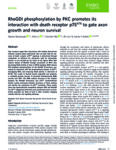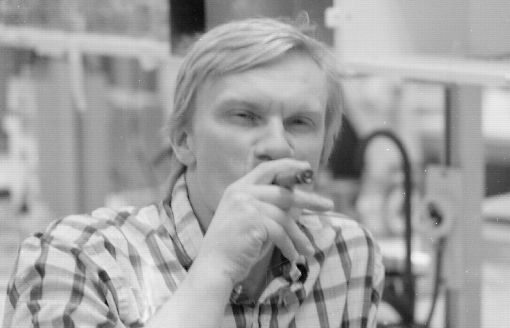Hakan Persson was Carlos Ibanez postdoc mentor and a remarkable person in many ways. As a young professor at the Karolinska Institute, Hakan was a seemingly endless source of energy and inspiration for his colleagues and students. His skills and enthusiasm, together with a rare capacity to identify hot projects, allowed him, in only a few years, to reach the front of one of the most competitive fields in biomedical research.
Hakan founded the Laboratory of Molecular Neurobiology in the fall of 1987. At that time, Hakan moved from the Biomedical Center in Uppsala to the Karolinska Institute in Stockholm to take over a newly created professorship at the then Department of Medical Chemistry, today Medical Biochemistry and Biophysics (MBB). Together with Hakan, came one post doc and three students. In a short period, more students and post docs joined the group, which after six months had a dozen members. Right from its first days, the laboratory was characterised by an almost round the clock flurry of activity, with researchers running up and down a small corridor crowded with equipment, bookshelves and other assorted items. Much of the style of the laboratory was imposed by Hakan’s energetic, impulsive and informal character, an unusual sight in the Institute.
One of the research projects during the first days of the laboratory was the study of interactions between the nervous and immune systems; in fact some of Hakan’s early work pioneered the then newborn field of neuroimmunology. These projects addressed potential roles of known molecular markers from both systems in mediating exchanges of information between the brain and the immune organs. The group also began a search for novel molecules shared by the nervous and immune systems applying differential cloning techniques. Another area of research developing at the laboratory in those days involved expression studies of neurotrophic factors and their receptors, primarily nerve growth factor (NGF) and its at that time only known receptor, p75. This project was to grow into one of the most important areas of research at the laboratory.
The students that graduated at Hakan’s laboratory, Anders Ericsson, Finn Hallbook, Patrik Ernfors, Stefan Brene and Gisela Barbany, occupy today independent positions at different research institutions in Sweden. Patrik Ernfors returned to Sweden in the Fall of 1994 after a two-year post doc at the Whitehead Institute, and is currently Professor in Tissue Biology at MBB , Karolinska Institute. Ernest Arenas is also professor at at the same institution. Hakan’s postdocs included Wilma Friedman, Mei Ooi, Nils Lindefors, Carlos Ibanez and Madis Metsis. Wilam Firedman is professor at Rutgers University in the United States. Hakan’s premature death on May 16, 1993, meant a tragic loss for the Swedish biomedical community and for international neuroscience community. Carlos Ibanez took over the organisational and administrative responsibilities at the laboratory after Hakan Persson’s sudden death in the spring of 1993. He is currently Professor in Molecular Neurobiology at the Karolinska Institute.
On the 1st and 2nd of September, 1994, leaders in the field of neurotrophic factor research from both sides of the Atlantic gathered in Stockholm for a conference organised by the Wenner-Gren Foundations to honour the memory of Hakan Persson. Below is a transcript of the opening address to the Symposium of 1994 given by Hakan’s teacher and thesis supervisor, Professor Lennart Philipson.
Professor Lennart Philipson’s opening address to the memorial symposium for Hakan Persson
Hakan Persson was exceptional in many respects. He was a fabulous student, a good postdoc, a wonderful colleague and a close friend to a large international community of scientists. In 1975 at the age of 23, he started as a graduate student in the Department of Microbiology in Uppsala where his intelligence, energy and motivation were recognised from the first day. He was friendly to his colleagues and mentors and extremely helpful to postdoctoral students and visiting professors in the laboratory. He was absorbed and dedicated to science working long hours approximately sixteen hours a day, seven days a week.
His wife Katy, in her address to this meeting, referred to the memories of Hakan as a scientist in these early days. The intensity that he brought to his work was already at hand during his graduate years. If he had to be home at a certain hour and was in the middle of running a column, he took it with him on the bus to set it up in the refrigerator at home. When he acquired his own car, he ran out of gas many times on the short trip to the laboratory because the fuel gauge was on empty but he thought he could squeeze out just one more trip.
Hakan published his first paper two years after he started as a graduate student and received his Ph.D. four years later in 1979. At that time, Hakan worked on adenovirus which was considered to be the model for gene expression in mammalian cells. He focused on the E3 region of the viral genome which is unnecessary for replication in cell cultures but has a fundamental importance in vivo in controlling immune surveillance of virus infected cells. He was responsible for delineating several of the messenger RNAs in the E3 region and identified the product and participated in the early work on the interaction of the E3 19K protein with the heavy chains of the Class I transplantation antigens from mouse and man. After his Ph.D., he stayed in Sweden for three years as a postdoctoral fellow and an assistant professor before starting on a postdoctoral fellowship with Philip Leder who had recently moved into his new laboratories at Harvard Medical School.
Before he left Uppsala in 1982, he was determined to focus on neurobiology. He came into my office one day explaining that he wanted to postpone his scientific career in order to take an M.D. before he would be able to fully engage in neurobiological research. After forceful persuasion, he left for Harvard and started a career in science that in many respect, was exceptional. His three years in Boston were probably not the happiest scientific days in his life because Philip Leder wanted him to generate transgenic mice overexpressing the c-myc oncogene. Hakan never succeeded with this project but managed to make specific antibodies to the c-myc protein and thereby was one of the first to establish its role in growth regulation and in gene transcription. However during this time, he met his wife Katy McIntyre to make up for the scientific disappointment.
Hakan returned to Uppsala University in 1985 and took up a position as associate professor in the Department of Medical Genetics first working on the myc-oncogene. Shortly thereafter, he explored the new field of molecular neurobiology through a large network of collaborations within Sweden and later on internationally. He started off as an autodidact in neurobiology and focused on neuropeptides and then on neurotrophins and their receptors. Ted Ebendal in Uppsala and Lars Olson and Tomas Hokfelt in Stockholm were his mentors during the initial phase, but Hakan soon transferred his molecular biology expertise to several areas of the neurosciences and became a spider in a research network of enormous dimensions. He moved to the Karolinska Institute in 1987 as a professor in molecular neurobiology and during the six years in Stockholm, he co-authored around 120 papers; 1 to 2 papers per month! He was highly respected internationally as revealed by the large number of well recognised scientists participating in this symposium to commemorate Hakan and his contributions.
Hakan had essentially only one minor deficiency. He was never aware that his research group constantly overspent its budget which forced the administrators to appoint friendly guardians to help him with his budgetary difficulties. However, when he discovered the new neurotrophin 4/5, the company Regeneron luckily provided enough resources so that his group became independently wealthy. Throughout his short life, Hakan stood out as the totally absorbed scientist who, in an unselfish way, gave to everyone of his knowledge, time and resources almost as if he knew that he would not live forever. I strongly believe, in line with his wife Katy and most of his scientific collaborators, that he would have been deeply touched by the contributions to this symposium but at the same time he was never on to rest on his laurels so after a while, he would have stood up impatiently and said “let us go back to work”. The papers in this volume illustrate the fast progress in the field of molecular neurobiology and they also demonstrate that the work of Hakan and his group had a major impact on neurotrophin research.
Lennart Philipson
Stockholm, September 1994



